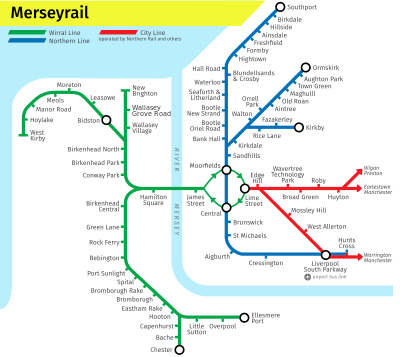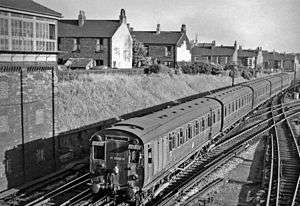Aintree railway station
- For a guide to the various Aintree stations that have existed and their relationship to each other see Aintree Stations.
| Aintree | |
|---|---|
.jpg) | |
| Location | |
| Place | Aintree |
| Local authority | Sefton |
| Coordinates | 53°28′26″N 2°57′23″W / 53.4740°N 2.9563°WCoordinates: 53°28′26″N 2°57′23″W / 53.4740°N 2.9563°W |
| Grid reference | SJ366978 |
| Operations | |
| Station code | AIN |
| Managed by | Merseyrail |
| Number of platforms | 2 |
| DfT category | E |
|
Live arrivals/departures, station information and onward connections from National Rail Enquiries | |
| Annual rail passenger usage* | |
| 2010/11 |
|
| 2011/12 |
|
| 2012/13 |
|
| 2013/14 |
|
| 2014/15 |
|
| Passenger Transport Executive | |
| PTE | Merseytravel |
| Zone | C1/C3 |
| History | |
| 2 April 1849 | Station opens |
| ? | Renamed Aintree Sefton Arms |
| 6 May 1968 | Renamed Aintree |
| National Rail – UK railway stations | |
| * Annual estimated passenger usage based on sales of tickets in stated financial year(s) which end or originate at Aintree from Office of Rail and Road statistics. Methodology may vary year on year. | |
|
| |

Aintree railway station is a railway station in Aintree, Merseyside, England. It is on the Ormskirk branch of the Merseyrail network's Northern Line. Until 1968 it was known as Aintree Sefton Arms after a nearby public house. The station's design reflects the fact it is the closest station to Aintree Racecourse, where the annual Grand National horse race takes place.
History
Opened by the East Lancashire Railway in April 1849, then taken over by the Lancashire and Yorkshire Railway ten years later, it became part of the London, Midland and Scottish Railway during the Grouping of 1923. The line then passed on to the London Midland Region of British Railways on nationalisation in 1948.
The L&YR electrified both routes from Liverpool Exchange in 1906 (two years after a successful trial of the system on the neighbouring line to Southport),[1] extending it subsequently as far as Ormskirk by 1913. The western end of the North Mersey Branch from Gladstone Dock & Bootle (which had opened in 1866 and joined the main line immediately south of the station) was also equipped with the third rail in 1914, though Gladstone Dock station only remained open for passenger trains until July 1924. Services henceforth ran only to Bootle Oriel Road and on to Exchange until they were withdrawn by the British Transport Commission on 2 April 1951.[2] The main line via Walton was also used by longer distance local & express trains from Exchange to Preston, Blackpool, Scotland and East Lancashire in addition to the intensive electric commuter service and some of these also stopped at Aintree, especially when the nearby race course hosted the famous Grand National meeting.
The Ormskirk line wasn't included in the list of routes to be closed in the 1963 Beeching Report (unlike the other two routes from Liverpool Exchange), but the route was subsequently reviewed by BR and reprieved in 1966.[1] This came at some cost though, as all through trains between Liverpool, Preston and East Lancashire were to be either re-routed via Wigan North Western to Liverpool Lime Street or withdrawn altogether. These alterations were mainly carried out in 1969, with all through running beyond Ormskirk ceasing from 4 May 1970.[1] Exchange then closed to passengers on 30 April 1977,[1] with services henceforth being integrated into the Merseyrail Northern Line and running via the new Link tunnel to Liverpool Central from the following Monday (2 May).
The North Mersey line lost its connection into the docks in 1971, though it remained in use to serve a permanent way depot at Fazakerley until 1987 and for periodic engineers trains to/from Bootle & Edge Hill thereafter. It has seen no traffic since 2005, but Merseytravel has long term ambitions to reopen it to passenger trains (as stated in the Liverpool City Region Long Term Rail Strategy published in 2014[3]).
When Sectorisation was introduced, the station was served by Regional Railways on behalf of the Merseyside PTE until the Privatisation of British Railways.
Services
On Mondays to Saturdays, trains run every 15 minutes towards Liverpool Central and every 15 minutes towards Ormskirk. On race days, the trains have 6 carriages (two trains coupled together). During the Grand National meeting, additional trains run to the station from Liverpool city centre. Connections for stations to Preston are available at Ormskirk.
In the evening and on Sundays, trains call every 30 minutes in each direction.[4]
Gallery
-

An LMS 630v EMU approaching in 1959.
-
.jpg)
The view south along the Liverpool-bound platform.
-

The station building viewed from the car park.
-
.jpg)
A Merseyrail Class 507 departs with a service.
References
- 1 2 3 4 "Disused Stations - Liverpool ExchangeDisused Stations; Retrieved 29 March 2016
- ↑ "Disused Stations - Linacre RoadDisused Stations; Retrieved 29 March 2016
- ↑ "Merseytravel plan to open or reopen host of new stations" Shennan, P; Liverpool Echo news article 28 August 2014; Retrieved 29 March 2016
- ↑ GB eNRT 2015-2016 Edition, Table 105
- Butt, R. V. J. (1995). The Directory of Railway Stations: details every public and private passenger station, halt, platform and stopping place, past and present (1st ed.). Sparkford: Patrick Stephens Ltd. ISBN 1-8526-0508-1. OCLC 60251199.
- Jowett, Alan (2000). Jowett's Nationalised Railway Atlas (1st ed.). Penryn, Cornwall: Atlantic Transport Publishers. ISBN 0-9068-9999-0. OCLC 228266687.
External links
| Wikimedia Commons has media related to Aintree railway station. |
- Train times and station information for Aintree railway station from National Rail
- Station information for Aintree railway station from Merseyrail
| Preceding station | |
Following station | ||
|---|---|---|---|---|
| Old Roan towards Ormskirk |
Merseyrail Northern Line |
Orrell Park towards Liverpool Central | ||
| Disused railways | ||||
| Terminus | Lancashire and Yorkshire Railway North Mersey Branch |
Ford | ||